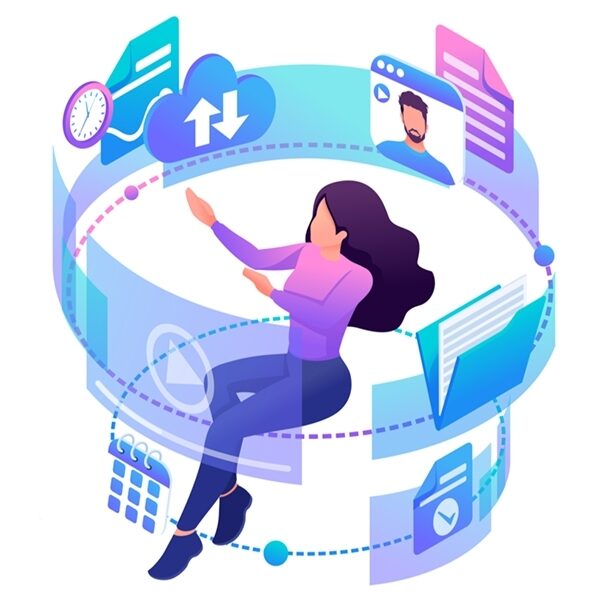
This blog was originally published on EdSurge.
When new colleagues start work at The Learning Accelerator (TLA), they’re often surprised that one of the first “required” organizational readings is actually a 2014 video called “Conference Call in Real Life.” It humorously manages to cover the slightly charming but, more so, annoying aspects of remote work, including dropped calls, distractions, awkward interactions and a cameo of Rex the dog.
As a virtual nonprofit, we share the video to playfully poke fun at one of the biggest challenges we face: collaborating effectively on a daily basis while physically being thousands of miles apart. By confronting this reality directly, we’re better able to explicitly tackle obstacles and build systems and cultural norms that create a remote-first rather than remote-friendly workplace, which aids productivity and communication.
New Resources for Assessing and Designing Online Adult Learning
Our team recently took on a project to understand effective online teacher learning — the results of which have been published in partnership with EdSurge Research. Given TLA’s context, it comes as no surprise that we discovered many parallels between our day-to-day operations and what we found in the literature on adult learning. Indeed, our research on emerging online tools (often called Asynchronous Learning Platforms, or ALP) focused on how educators build skills and knowledge together, remotely. While technology offers opportunities in online teacher learning like access, flexibility and personalization, it also poses significant challenges, such as feelings of isolation and demands on self regulation. We gain little when we simply replicate in-person approaches, say lectures, online because we fail to take advantage of these new possibilities—and also fail to mitigate risks. Several meta-studies of the efficacy of adult online learning programs support this. So what should educators, and the people that support them, look for when choosing online adult learning options?
Six Drivers for Quality Online Adult Learning
To develop a deeper understanding of what makes for high-quality online teacher learning experiences, our team explored over 100 peer-reviewed research papers and meta-studies looking for common patterns and mechanisms. Through this research, we identified six primary drivers for quality, which we categorized into three buckets.
The first, and perhaps most obvious, is the user experience of a learning tool, which acts as a baseline for quality. Put bluntly, the platform needs to be easy and engaging for teachers or they won’t use it.
The second bucket is made up of three factors that are common to good professional learning—rigorous, relevant content that is experienced actively and focused on mastery. Whether online or offline, these factors matter to all learners because they support deep engagement with ideas and concepts in ways that are most likely to support transfer of new knowledge and skills to practical application across contexts (be it the classroom or any work environment).
But it’s the third bucket of drivers—connection and personalization—that makes up the “secret sauce” for effective learning (and good remote work). Learners and remote employees alike risk disengagement in a virtual setting, given the perceived distance and need for self-direction and persistence to connect with others. Therefore, designers of learning and work experiences should consider how they’ll explicitly build social presence in the community as well as ensure adults are engaged in work that is tailored to their needs. In our work at TLA, as is true for teacher development, the latter has been a function of understanding our colleagues’ goals, interests and learning needs. We also orient heavily around our company’s shared mission. But it’s the work on the former—connection to each other—that has required additional creativity and innovation.
Making Connections: GIFs Count!
So what did the research tell us about building connections in online professional learning and at TLA?
First, connection does not usually happen organically, at least not at the level needed to foster deep collaboration and engagement. A learning or working community must create the conditions for participants to develop a level of trust, respect and understanding that encourages risk-taking and the open sharing of ideas and feedback. Doing this in a remote environment can be tricky, as participants lack the same face-to-face relationship building and social cues. It takes significant work and facilitator-led cultivation to bridge gaps and keep engagement going. Given this, leaders or learning efforts have to devote time and energy to making sure connections are created and sustained. At TLA, we have a strategy for connecting and communicating well, which includes some pretty non-organic practices like embedding personal check-ins and success sharing into our weekly meetings as well as sending values-aligned “shout-out” postcards to team members to help build understanding and rapport.
Second, small efforts can have a huge impact on the culture of a learning or working community. At TLA we often joke that every employee has to develop some serious GIF skills—we often communicate through memes and photos. We also use emoticons to indicate how we’re each feeling at the start of a meeting. These behaviors can feel like superfluous fun, but it turns out the research supports how this “paralanguage” (that is, nonverbal, often less formal communication mechanisms) is critical to humanizing interactions, creating community and increasing satisfaction. And these behaviors have got to be embraced and exhibited by every community member to be effective.
We’ll be thinking a lot about these findings as we continue to develop TLA as well as push for better adult learning experiences for educators, the future of which is brighter than ever. We need not move fully online, but if we use what we’ve learned from the scientific literature and from emerging strategies, we could make professional development a whole lot more accessible and effective for educators.
I often get asked by peers and potential employees why running our nonprofit remotely is core to our organizational strategy. Sure it’s challenging at times, but my answer is clear: being remote allows us tap into resources and ways of working that are usually impossible. We can hire talented colleagues from anywhere in the country, and we don’t lose great people should life dictate a physical move. We can be more flexible; instead of commuting to an office or scheduling personal appointments outside of nine-to-five, we build efficiencies that allow more time with kids, taking personal care and engaging in our communities. We work hard, and smart.
Through the launch of these new resources, we’re excited to share what we’re learning and help educators and the people who support them make informed choices about professional learning strategies and tools. And we’re eager to hear from you. Let us know what you think!

